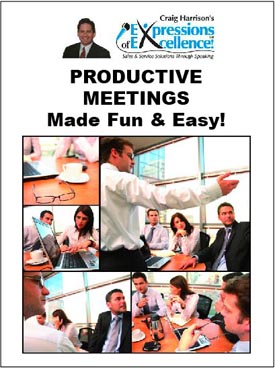![[Home]](../GIFs/LatestEofEHead.gif) |
•
Speaker • Trainer • Consultant • Coach • Facilitator • Emcee • Storyteller |
||||
 |
MEETINGS Made Fun & Easy! |
| Does the thought of running a meeting make you want to run away? It needn't. You may actually be better equipped than you realize to preside over meetings. With a pinch of preparedness, a dash of common sense and a shot of confidence you can meet meetings head on, and walk away intact! The Agenda — Your Roadmap to Success With clear driving instructions it doesn't matter whether you drive a motorcycle, Winnebago or hook & ladder fire truck; the same holds true for meetings, whether in a business, association or public setting. The written agenda is your guidepost for where you and your other participants are going. By sharing, in writing, the planned agenda, all will share your understanding of the day's activities, and can help steer it. Whenever possible, share the agenda in advance for your meeting. Come meeting time it will steer you well. What About Bob and His Rules?Meetings generally follow Robert's Rules of Order, whether participants are Parliamentarians or not. Robert's Rules were conceived to impose order and fairness in meetings. Many of these rules are common sense. For instance, only one person can speak at a time, or that the will of the majority prevails while the rights of the minority are always taken into consideration. Consider the following: a bunch of your friends are deciding what to do this afternoon.
One person has just made a motion and another person "seconded" it. That's Robert's Rules in action. Now others discuss it: some are in favor, some would rather watch the 49ers on TV. Soon it's time to decide what the group wants. (This is a call for the vote.) Five vote to roller blade and two want to watch the 49ers. The majority wins and the announcement is made: "Blading we go." That's how a main motion is handled. Meet them at the YBefore you schedule your meeting, be sure you can answer for yourself and others why your meeting is necessary. Can its purpose be achieved via memo, e-mail, or a one-on-one meeting? Remember, a twenty minute meeting with 8 others represents three hours of company work time. Multiple that times salaries of the attendees and you can begin to see the high cost of meetings. Do the results justify the expense? As for who is invited, make sure to have the people capable of moving forward with the business at hand. Nothing frustrates like realizing in mid-meeting that key decision makers are missing. Object to Missing ObjectivesOne of the primary difficulties in meetings is achieving the desired objectives. When everyone knows the objectives, all can be cognizant of their achievement. Don't lose sight of the reason for the meeting. Post objectives at the top of your agenda. At meetingâs end, reiterate the objectives and determine if they've been met. If not, remind people of your focus to keep objectives foremost in peoples' mind. Reports vs. SpeechesFor committee meetings your officers, chairs or attendees should be prepared to deliver summary reports stating the facts as concisely as possible. Prepare to offer more details only if and when requested. Reports cover highlights and address problems or outstanding issues. They aren't speeches! If pictures are worth a thousand words, so too is a brief handout with charts, tables or graphs. Many prefer data in print for further reference so consider a handout in lieu of a longwinded report. My tip to keep speakers focused: ask that each report be given while standing. The Long and Winding RoadMany well-intentioned meetings get side-tracked by long windedness or out of control discussions better handled in smaller meetings or by committee. If your meeting is being held hostage by such a discussion, appoint someone to chair a subcommittee, promptly refer it to that group, and move on! They can report back without draining the overall groupâs time. Before AdjourningMake sure to review (and have your meetingâs secretary record) action items of each attendee before adjourning. This reminder insures everyone leaves with the same understanding, and helps record the group's progress. Also set the time for the next meeting. Remember, the more that gets done between meetings the longer you may be able to go until your next one. While an all-meet diet can be hazardous to your health, good things can and do come from meetings. When conducting yours, remember to keep them professional, keep them fun and mostly, keep them moving! Craig Harrison teaches courses on productive meetings for UC Santa Cruz Extension's Business Administration department. Read about Craig's MEETINGS course. Order his workbook on Meetings: Book Craig to teach this class for you:
|
|